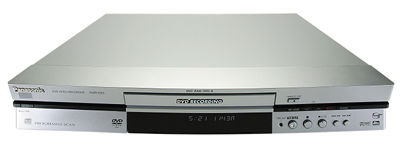Panasonic DMR-E50 DVD-RAM/R recorder

As you probably know by now, there are three major formats of recordable DVD: DVD-R/RW, DVD+R/RW, and DVD-RAM. Of these, the first two are designed to create discs that are compatible with most modern DVD-Video players, and they succeed in this goal to one degree or another. (DVD-RW can also record in what is called VR mode, which offers more editing capabilities at the expense of general compatibility with conventional players.) On the other hand, DVD-RAM was designed by Panasonic as a computer-oriented data-storage format that can also record video material. While recordings made in this format are not compatible with most DVD-Video players (except for Panasonic's own players, starting with the 2003 line), they do offer some unique advantages and features not available with the other formats.
The DMR-E50 is Panasonic's fourth-generation DVD-RAM recorder, and it can also record onto DVD-R blanks if you wish to make discs that are compatible with most DVD players. This flexibility lets you decide which is more important for a given recording situation: compatibility or enhanced functionality.
Appearance
The DMR-E50 is a sleek silver unit with a relatively simple front panel. The display is well-designed, with an alphanumeric readout and several fixed indicators for things like record mode (which determines image quality and amount of recording time), display mode (whether the alphanumeric readout is indicating title, track, chapter, program, or playlist number), disc type, timer recording, and record/playback status (running or paused).
To the right of the display are several control buttons, including Play, Stop, Skip/Slow/Search Forward and Backward, and Time Slip (more in a moment). Above these controls are several thin buttons that include Channel Up/Down, Record, Rec Mode, and Erase. Below and to the left of the display is a fold-down door that conceals the front-panel inputs (S-video, composite, L/R audio).
The rear panel is simple and well-organized, with two inputs and one output that each provide S-video, composite, and L/R analog audio connectors. There's also a progressive/interlaced component output, optical digital audio output, and RF in and out.
The remote is designed to operate the E50 and a TV from any of various manufacturers. I particularly appreciate having the Open/Close button hidden behind a sliding cover (along with several other infrequently needed controls) so it can't be pressed accidentally. Adding or deleting channels manually is much easier than usual, thanks to the Channel Add/Delete button. And the Commercial Skip button is especially welcome, although it advances the playback by one-minute steps; many commercial breaks are two and a half minutes, so 30-second steps would be more useful.
Overall, I found the main menu system to be relatively intuitive and easy to use, even without consulting the manual (which is typically dense but surprisingly helpful, with an index in addition to a detailed table of contents). Some items, such as Play/Resume Play and Play From Top, activate the specified function immediately, while others, such as Setup, Timer Recording, and Create Play List, call up associated sub-menus.

A separate menu is activated by pressing the Display button, which provides access to various disc, playback, video, and audio controls. But while the Display menu can be called up when a disc is playing or paused, you must stop the disc to call up the main menu.
Recording and Editing Features
As a consumer video recorder, the DMR-E50 includes full VCR functionality, including a 16-program timer and VCR Plus+. The timer is very well designed, and you can even enter the titles of shows to be recorded—a unique and very cool feature.
The E50 can record up to six hours on DVD-R or single-sided DVD-RAM discs, and up to 12 hours on double-sided DVD-RAM (although you must manually turn the disc over, so you can't record more than six hours continuously). Like all of Panasonic's DVD-RAM recorders, the E50 doesn't need to use disc cartridges, although it can accommodate them; Panasonic touts cartridges as a protective feature, but they are more expensive than bare discs.
As with any video recording device, the E50 offers several record modes that trade image quality for recording time: XP (1 hour, highest quality), SP (2 hours), LP (4 hours), EP (6 hours, lowest quality)—of course, double these times for double-sided discs. Also available is FR (Flexible Recording) mode, which uses the highest possible quality to fit the entire program within the available space on the disc.
The E50 encodes video signals using MPEG-2 with a variable bit rate; lower rates are used for simple scenes, while higher rates are used for complex scenes with lots of motion. Philips also uses a variable bit rate in their DVD+R/RW recorders. By contrast, Pioneer's DVD-R/RW recorders use a constant bit rate, except with DVD-RW in VR mode. The E50 records audio in Dolby Digital 2.0.








































